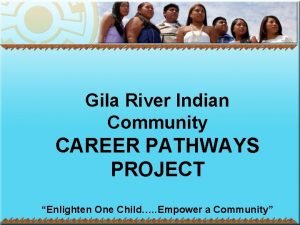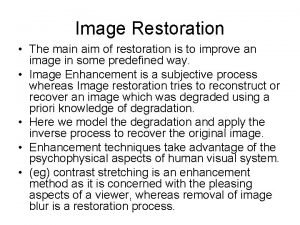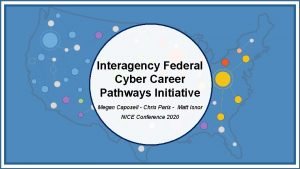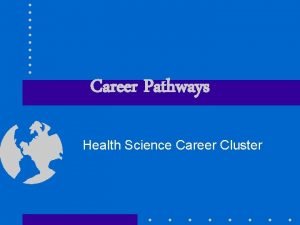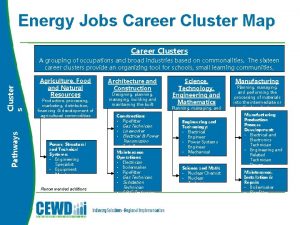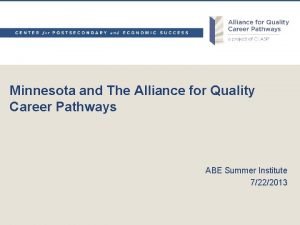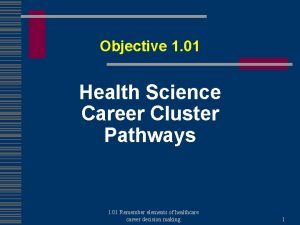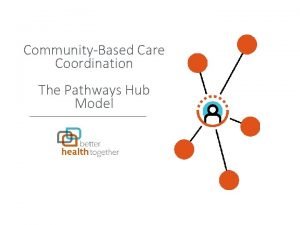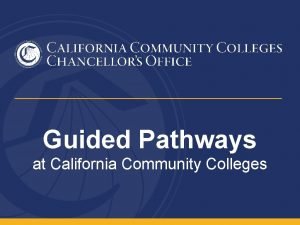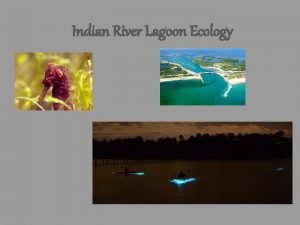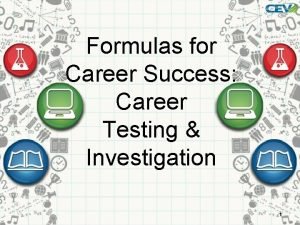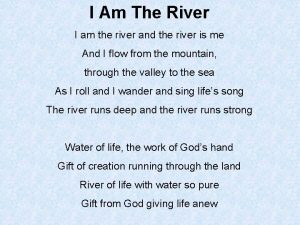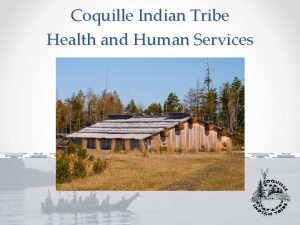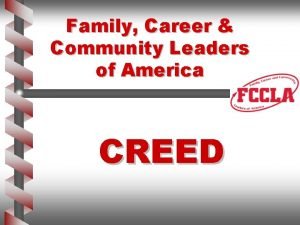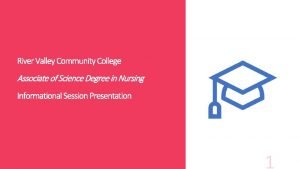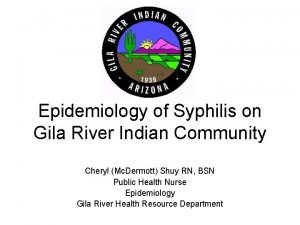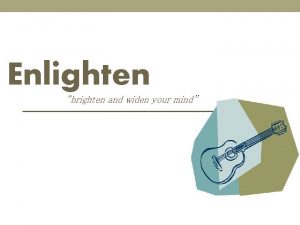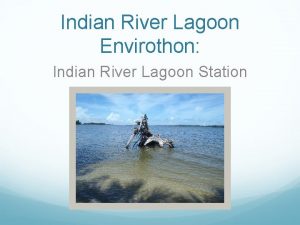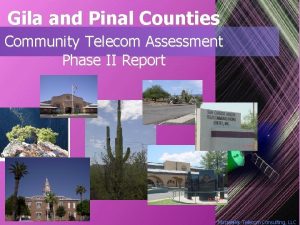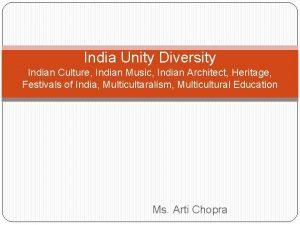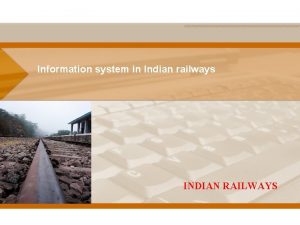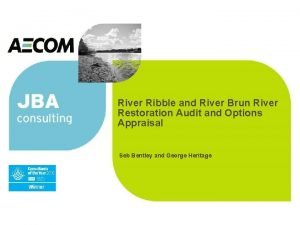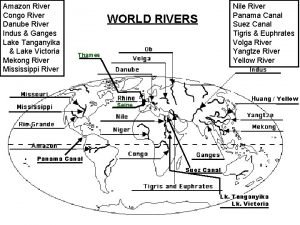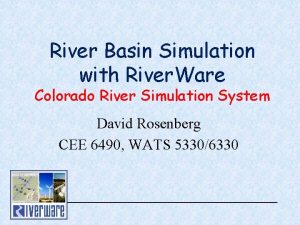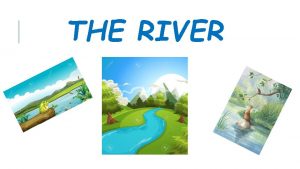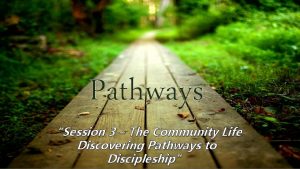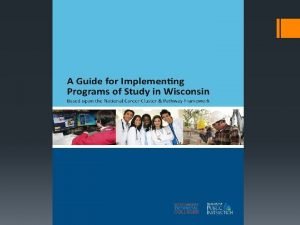Gila River Indian Community CAREER PATHWAYS PROJECT Enlighten

























- Slides: 25

Gila River Indian Community CAREER PATHWAYS PROJECT “Enlighten One Child…. . Empower a Community”

Grant Opportunity History • Two Native WIA Grantees were selected by DOL to participate in a “Career Pathways Technical Assistance Initiative”, along with 9 other selected State WIA Service Delivery areas • Of the 10 selected WIA Grantees, Gila River Indian Community and Tucson Indian Center share one of the 10 spots. We are the only Native American Grantees in the initiative. • Initiative Purpose: To support the development of a comprehensive career pathway model for adult and dislocated workers

Serving the Most In Need • Unemployed – Individuals in need of training to gain the skills needed to obtain and retain employment. • Low income – Individuals receiving cash payments under a Federal, State or local income based public assist program. (General Assistance, TANF, AFDC, TPEP and Unemployment Benefits) • Under-employed – Individuals in need of training to upgrade their current skills to retain employment. • Our Career Pathways Grant is an adult grant, but we have expanded it to include youth in the High School System because we believe awareness must begin there

What is “Career Pathways ? • A systematic approach that connects job training, education and employment systems • A program designed around the needs of today’s working learners • A model that engages employers in the program design and curriculum development • An easier program for (working) adults to access occupational skills training programs and where appropriate combines them with adult basic education • A Program that increases credential attainment by modularizing curricula into smaller units Portable, stackable, chunk-able units

“Career Pathways” Model Elements • • Aligned with the skill needs of industries located in the Community A full range of secondary, adult education, and post secondary education options Curriculum & instructional strategies that make “work” a central context for learning Work readiness skills Integrated education & job training Credit for prior learning Has the goal of increasing an individual’s educational and job skills attainment and employment outcomes • • • Lead to an industry recognized degree or credential of value in the labor market Accelerates career advancement Stackable credentials that lead progressively to higher level credentials or degree Academic & career counseling wrap around support services at points of transition and during program Accommodating work schedules, & non-semester based scheduling, alternative class times & locations Innovative use of technology

Grant Activities • Organized a Team of decision makers to develop a Community Plan that meets local needs, CORE and RESOURCE Teams • Identify and engage employers in the development of the plan • Hold regular meetings of Team Members to gather information for the model • Attended one 3 day Training Institutes with experts in Education and Labor - one on November 2010 and will attend a second one in the Spring 2011 in Washington, DC • Identify where policy and system changes need to be made in the Community • Create a presentation and Best Practice Booklet for presentation at the National WIA Conference and for the Tribal WIA Advisory Council • Coordinate efforts and activities with the Tucson Indian Center • Final Outcome: A Model that will streamline job training for Community Members and create lasting partnerships between employers, Community Department and Schools

About The Institutes • Fall Institute - November 30, th– December 2 nd in Washington, D. C. • DOL provided opportunities to meet with issue experts in Education and Workforce Development to obtain technical information and encourage idea exchange. They provided us with note-takers, resource guides, planning templates, and sample policies and guidelines. We learned how to map out our first Career Pathway and heard from all of the States and their progress over the years. Spring Institute - April 26 – April 27 in Washington, DC DOL will focus on “Credentials that Count” i. e. , increasing credential attainment through better program design and policy alignment. For this next session we must choose one career area to focus on.

What We Found. . . • • Disjointed training efforts in Community Employers do not know how to access Community Services Unskilled Applicant Pool Lack of awareness of employer services Employers not talking to each other or about sharing resources Employers have to go outside to find the skills they need in their workforce Resources could be saved if we consolidated efforts • • • Disconnected youth and adults Youth don’t see a connection between work and learning in high school Lack of Awareness of jobs/services and opportunities in Community Do not have consolidated information regarding the grade school/high schools located within GRIC Unclear Supportive Services available throughout the Community After the fact training: not getting employer information before they begin to hire

Assets • Close Knit Community • Employers Have The Same Focus – Hire Community Members • Variety of Jobs Available • Close to Casa Grande and Phoenix Area • Housing Assistance • Child Care Available To Those That Qualify • Close to Schools • Education Scholarship Program • District Services • Culture

Schools Gila River Indian Community o K-12 School System High Schools o Ira Hamilton Hayes High School § 55 students o Vechij Himdag Maschamudkud § 53 students o Off-Reservation Boarding Schools § 126 Students o Off-Reservation High Schools § Majority of GRIC

Youth Issues Remembering the Youth o Major Issues at Adolescent Level Ø Crime Ø Poverty Ø Gangs Ø Truancy Ø Motivation Ø Lack of Direction Ø No Mentorship Ø Cultural

Higher Education Colleges/Universities – In the process of creating a true partnership in which the Community can appropriately train and credential future workers for the enterprises and other local demand occupations that the local economy has available. Develop portable credentials. o Central Arizona College o Mesa Community College o Future Educational & Training Providers

Trainers and Mentors Local Trainers o Many Skilled Community members classically trained o Credential prior experience & training o Certified Trainers Career Pathways Mentors Identification: – Schools would identify Career Pathway Mentors in the school system who would begin steering future workers towards an appropriate Career Pathway given their interests, talents, and abilities. Once they leave the High School system another Career Pathway’s Mentor would be identified.

GRIC Plan Employer Elements

GRIC Plan Department Elements • DEPARTMENTS • Community Departments – Departments such as Employment & Training, TERO, Education, Social Services, Child care Services, etc would become united in working together to develop a workforce that would be ready to take the most skilled positions, management positions and positions within the government structure when openings occur. • Sharing Resources- Departments would identify all resources within the Community and possible create a resource handbook and website that all of the Career Pathways Partners could utilize. This would include resources and opportunities available within the Enterprises’ training programs as well. • Work Readiness/Life Skills Training – In order to prepare the workforce for employment, a strong work readiness/life skills component will be developed at all levels i. e. school, for adults etc. throughout the Career Pathways Program • Career Pathways Mentors Identification: Departments would identify those in the Community Departments who would be Career Pathways Mentors so that from school through adulthood there would be mentors assigned

GRIC Plan Support Elements

GRIC Plan Sustainability Elements • SUSTAINABILITY – • Career Pathways Advisory Board – A permanent Team will be created in order to sustain the project for years to come. This Team will be made up of key stakeholders within in and outside the Community. Regular meetings will be developed in order to stay on top of student/adults or of new resources that can be used for the streamlined program. • Tracking – a method will be developed to track Gila River Students/Adults through the model from within the schools to adulthood to employment. Each Career Pathways Mentor will be responsible for his/her area and forward on names to the next Mentor as the participant moves through the system. • Marketing – Will develop a marketing strategy for the program in order to foster buy in from Districts, Departments, Council, Employers, Community and other elected Officials. This includes a video, a website, brochures, common application, etc.

Labor Market & Occupations in Demand We are developing labor market surveys to become better aware of Employer needs. We will continue to work on this area as we develop our six areas of Career Pathways. So far we have identified the following areas. We will be developing the first three: • • • Medical Occupations Hospitality/Gaming Construction/Green Information Technology Administrative • • Environmental Government Management Small Business Management



Policy Changes A successful Career Pathways System requires policy change: • • High Schools - change curriculum and make learning more relevant to what is available in their Communities Colleges – Development of “employer” generated credentials for those not seeking degrees not only the traditional degrees Employers – Develop a mechanism for hiring those who have come through the Pathways System Employers - Work with the entry level worker in identifying a pathway into advanced positions Employers – work together to create unified training where it makes sense so more resources can be shared Education Department - Expand the scholarships tuition program to include short term credentials and “open entry” applications for scholarships Education Department – Work in new and different ways with School Boards, VHM, Ira Hayes and GED Programs within the Community

Next Steps • • • Develop Marketing Materials Complete Labor Market Survey Design “Electives” Curriculum For High Schools Develop a Presentation Schedule to the Districts, Council, Schools, DES, School Boards, National Conference, Employers Map out pathways in all three identified industries Add info on tuition amounts and what schools will deliver Career Pathways Develop a universal manual and application Develop MIS tracking system Identify High School Mentors

Why Career Pathways? Listen to the experts: • • Kara Jones - District 1 Blackwater (Speaker for group) Kayla Enos - District 3 Sacaton Christina Manuel - District 1 Blackwater Amy Rhodes - District 3 Sacaton

Gila River CORE Team • • • Gila River Indian Community – Lana Chanda, Director of Employment & Training and Grant Lead Gila River Indian Community – Eulonda Martinez, WIA Coordinator, Employment & Training Gila River Indian Community – Andy Miritello, Building Trades Instructor, Employment & Training Department Central Arizona Association of Governments (CAAG) – Al Larson, Career Pathways Weatherization Coordinator Huhukam Hospital – Jesse Juarez, HR Specialist • • • Gila River Indian Community – Chris Banham, Off Reservation Boarding Schools, Tribal Education Department Gila Pinal Workforce Investment Area – Marty Clay, One Stop Manager, Business Service Representative Mesa Community College – Jackson Harris, Hoops of Learning Coordinator Gila River Indian Community – Stephanie Sauceda, TERO Director Wild Horse Pass Casino – Herb Clah, Human Resource Director

Wrap Up Questions? ? ?
 Gila river employment and training
Gila river employment and training Www youtube com
Www youtube com Gila county food handlers
Gila county food handlers Entertain purpose
Entertain purpose Contra harmonic mean filter
Contra harmonic mean filter Enlighten the darkness of my heart
Enlighten the darkness of my heart Graphs that enlighten and graphs that deceive
Graphs that enlighten and graphs that deceive Cyber career pathways tool
Cyber career pathways tool Verizon career pathways
Verizon career pathways Career cluster define
Career cluster define 5 health care career pathways
5 health care career pathways Energy career cluster pathways
Energy career cluster pathways Quality career pathways
Quality career pathways Health science career cluster jobs
Health science career cluster jobs Wisconsin career pathways
Wisconsin career pathways Hub care coordination systems
Hub care coordination systems Guided pathways california community colleges
Guided pathways california community colleges Indian river lagoon seagrass
Indian river lagoon seagrass Indian river inlet dangerous
Indian river inlet dangerous Launchpad fcs
Launchpad fcs Formulas for career success career testing & investigation
Formulas for career success career testing & investigation Green river (duwamish river tributary)
Green river (duwamish river tributary) I am the river and the river is me
I am the river and the river is me Coquille indian tribe community health center
Coquille indian tribe community health center What is the fccla creed
What is the fccla creed River valley community college
River valley community college
